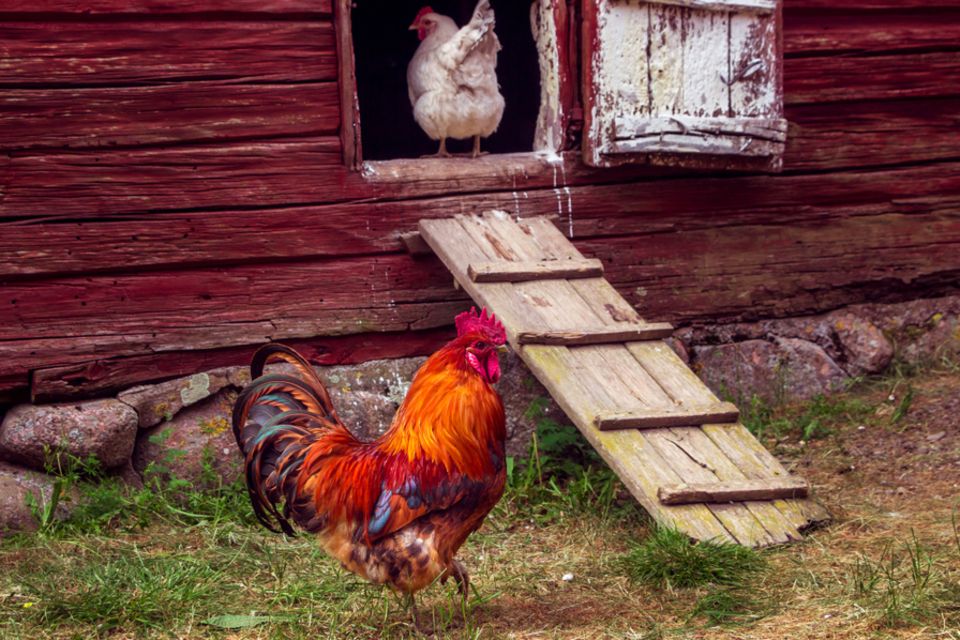Keeping chickens
The best tips for beginners
© bernatets photo / Shutterstock
Keeping chickens is also possible in the city. You can find out what holders should pay attention to here.
Whether self-made natural cosmetics, making food yourself (e.g. making yoghurt yourself), cultivating your own vegetable garden or a raised bed on the balcony – everyone can contribute to their own self-sufficiency even with small steps. If you also want to keep chickens, you not only have adorable pets, but also regularly have fresh eggs. Before they come to the breakfast table, there are a few things to consider.
Keep chickens in town
Keeping chickens is not generally forbidden, aaab … it's not that easy after all. Because it's not just you and your chickens: you shouldn't ignore the community, the landlord and the neighbors. Find out from your local authority whether it is allowed to keep animals in your area. If you live to rent, you should discuss the keeping of chickens with the landlord in advance. And you better not leave your neighbors out either, because thoughtfulness is the top priority here. Especially if you want to keep a rooster next to the hens – the Kikeriki can quickly lead to Mimimi and land in court. Keeping chickens is probably prohibited from the outset in the allotment garden association, so it is better to check the statutes before the spring-loaded roommates move in.
The choice of chicken breed – and the rooster question
Which breed of chicken is the right one? Each breed has its own characteristics and there are also considerable differences in appearance. When making your selection, you should consider the space available (run and stall) with the space required by the respective breed of chicken: If you do not have a large garden, it is best to choose a small breed of chicken that does not take up as much space as larger animals. The age of the chickens also depends heavily on the breed. You can about five to ten years old (in comparison: a laying hen in intensive animal husbandry is only about 20 months old). Think carefully about whether the chickens suit you and your lifestyle and whether you want to be responsible for several years.
When choosing, you should consider why you want to keep the chickens in the first place: because of the eggs, the meat or just for ornaments? Pay attention to the following points:
- size
- Laying performance
- Character traits (calm, spirited, …)
- Airworthy or lazy

© Nadezhda Kharitonova / Shutterstock
Does it need a rooster or not? A tap in the basket is not absolutely necessary, unless of course offspring is desired! The hens also lay eggs without these, however, a rooster can provide peace in the social fabric. If you have a group of six or more chickens, you can think about buying a rooster, otherwise it could become too stressful for them if there are too few hens. Without a rooster in the herd, a hen simply takes on the role of rooster in the pecking order.
Chicken coop and run
Chickens are not big pets, but they still need plenty of outdoor space. Calculate with about 10 square meters per chicken. Also think about Hiding places for the animals in the outdoor enclosure and to one fence, which must be correspondingly high for flying breeds.
Stable: size and equipment
In addition to sufficient exercise, poultry need a stable in which they can be safe from predators such as madmen or foxes, as well as sleep and protect themselves from bad weather. Peta 50plus recommends one for a hen house with ten chickens Size of 2 x 2 meters with a height of about 1.80 to 2.20 meters. Chicken coops are available in stores, and those who are skilled at handwork can also build them themselves. Before you set up a stable, find out whether you need a building permit for it. The regulations differ from state to state.
An alternative to the fixed one is a mobile chicken coop that can be moved accordingly. So z. B. the green area can be optimally used by the chickens.
This is how the stable should be equipped:
- Window for daylight
- Artificial light for the winter (possibly with a timer)
- Ventilation flap
- Lockable door
- Bar: Calculate about 20-30 centimeters per chicken
- Laying nests should be 25 or 30 x 30 centimeters or 40 x 40 centimeters, depending on the breed of chicken
- Dung board that needs to be cleaned regularly
- Feed trough
- Potions
- Litter (e.g. sand or untreated shavings)
How many chickens can I keep?
From a legal point of view, keeping fewer than 20 animals should not be a problem. However, you should not feel safe – in court, the individual case will be decided. The crowing of the rooster could become a big controversy in the neighborhood, because it does not keep to noon and night rest …
Sign chickens
Whoever wants to keep chickens takes responsibility. This includes regular vaccinations of the animals as well as registration with the responsible person Veterinary office and at the Animal Disease Fund according to the Animal Health Act. There may be (annual) contributions that have to be paid by the owner.
The time it takes to keep chickens © Goran Bogicevic / Shutterstock
Chickens are rather easy to care for, walking or playing is no longer necessary, but as a chicken farmer you should be prepared to invest some time. The daily effort is limited and ranges between ten and twenty minutes. In addition, the owner should observe the animals to see whether everything is healthy. Also, it is advisable to get a reliable one vacation replacement who can also step in in an emergency under certain circumstances.
Accumulate daily:
- Fill up with water and feedso that there is enough
- If possible, clean the manure board
- Collect eggs
- Open the flap in the morning or close it in the eveningn – with automatic flap check whether all the chickens are really in the barn in the evening
Other activities:
- Keep an eye on animalsto detect any diseases
- Thoroughly clean the stable and manure board on a regular basis
- Reliable (!) vacation replacement and organize short-term help, should you have to work longer and not be able to lock the poultry yourself
Old Vegetables That You Should Know About
7th
images
Chicken purchase, feed and costs
Chicken purchase
You can contact the local poultry breeders association to buy chickens, but special breed associations can also help. The Association of Chicken, Large and Water Fowl Breeders' Associations for the Preservation of Species and Race Diversity (VHGW) provides a list of poultry breeds and special associations on their website.
costs
- One-time costs: chickens, stable and fence
- Running costs: food, possibly fees for vaccinations and registrations
Chicken feed
The chickens eat grain feed such as wheat or oats, but also vegetable and kitchen scraps (e.g. cooked pasta or potato peels).
Summary: How to keep chickens in 8 steps
- Self-check: am I ready to take the time and commitments?
- Clarify the legal framework
- Check the conditions and size of the garden
- Choose breed of chicken
- Buy / build a chicken coop and prepare the run
- Buy chickens
- Registration and vaccination of the animals
- Ongoing care for the feathered roommates
Tip: In the BRIGITTE community you can exchange ideas with others about environmental issues and sustainability.
swell
Vier-pfoten.de
advocard.de
Peta50plus.de

